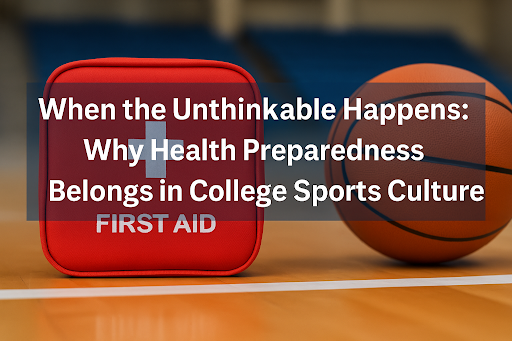On any given game day, the focus is on wins, stats, recruiting, and legacy. But behind the scenes, one element too often overlooked is health preparedness—so much so that teams in some regions go so far as to require a CPR course Ottawa certification for coaches or trainers. In college sports, where adrenaline, pressure, and physical exertion converge, having that level of readiness is more than optional—it’s part of being a responsible program.
In this post, we’ll explore how embedding health preparation into college sports culture strengthens teams beyond the scoreboard: protecting players, reinforcing trust, and elevating the identity of programs as caring, resilient, and holistic.

1. Risks Are Real — Even at Amateur Levels
It’s easy to assume that serious medical emergencies only hit pro or elite athletes. But in practice, the risks exist at every level of competition:
Cardiac events: Sudden cardiac arrest, while rare, is one of the leading causes of athlete fatalities.
Heat-related illness: Summer training camps or double sessions create high-risk conditions for heat stroke and dehydration.
Trauma injuries: Concussions, neck injuries, or severe collisions can escalate if not addressed quickly.
Spectator and staff safety: Emergencies aren’t limited to players. Fans, coaches, referees, or volunteers can also require rapid response.
College sports environments create pressure cookers: intense physical exertion, competitive stress, and large crowds. Without a plan, programs leave themselves and their athletes vulnerable.
2. How Preparedness Signals a Program That Cares
Recruiting athletes is no longer just about scholarships and facilities. Parents and players increasingly ask: Will this program take care of me beyond the stats?
Preparedness creates intangible yet powerful advantages:
Recruiting appeal: Families are more likely to commit when they know health and safety are prioritized.
Culture of respect: Athletes feel valued as people, not just as performers.
Community reputation: Alumni and donors take pride in programs that protect their athletes.
Crisis readiness: A calm, trained response prevents tragedies and protects the program’s image.
In college sports, reputation matters just as much as performance. Programs that invest in safety position themselves as leaders on and off the field.
3. Practical Steps for Teams & Programs
a. Certify staff and coaches
Every coach, trainer, or equipment manager should have baseline training in CPR and first aid. It doesn’t just save lives — it builds athlete trust.
b. Rotate refreshers
Skills fade over time. Annual or semiannual refreshers ensure staff maintain confidence in emergencies.
c. Equip facilities
Locker rooms, gyms, and stadiums should include first aid kits, AEDs, and clear emergency signage. Readiness is as much about tools as it is about people.
d. Run mock drills
Teams rehearse plays until they become muscle memory. The same principle applies to emergencies. Mock drills help staff and athletes know their roles when seconds matter.
e. Promote awareness among athletes
Athletes don’t have to be passive. Encourage players to understand basic signs of medical emergencies and support their teammates when needed.
4. Stories That Matter
Real-life examples prove the value of preparedness. Across the U.S. and Canada, there are numerous stories of athletes saved because someone acted quickly. From a trainer administering CPR on the sideline to teammates stabilizing an injured player before EMS arrived, these moments remind us of the stakes.
Imagine a college basketball tournament where a player collapses mid-game. A staff member trained in first aid responds immediately, while another calls for medical services. The player stabilizes, recovers, and even returns later in the season. Without training, that story could have ended in tragedy.
These stories rarely make national headlines—but inside athletic circles, they define a program’s legacy far more than a single win or loss.
5. Overcoming Barriers & Resistance
Some programs hesitate to add new requirements. Common objections include cost, time, or a belief that emergencies “won’t happen here.” But these arguments don’t hold up under scrutiny.
Cost: Group training reduces expense, and the price of prevention is far lower than the cost of crisis.
Time: Courses are often one day or hybrid formats, making them manageable even in-season.
Probability: Emergencies may be rare, but when they happen, stakes are life and death. Preparedness isn’t about likelihood — it’s about impact.
Programs that resist risk being defined not by their wins, but by their failures to protect their people.
6. The Bigger Picture: Culture and Leadership
Preparedness isn’t just a logistical decision — it’s a cultural one. Leaders who champion health and safety demonstrate empathy, foresight, and responsibility. These qualities ripple through the program, shaping how athletes carry themselves on and off the field.
Athletes trained in environments that value safety often become leaders themselves, carrying those values into coaching, careers, and communities. By prioritizing preparedness now, programs shape the future culture of sport.
Final Thoughts
College sports are about passion, performance, and legacy. But real legacy isn’t just measured in trophies or records — it’s reflected in how programs care for their people. Integrating readiness, whether through staff certification, drills, or facilities, strengthens a program’s foundation.
By embedding practices like CPR and first aid training into the culture, athletic programs show that they value players as individuals, not just athletes. In a competitive world, the programs that win on culture and character often leave the deepest mark.
When the unthinkable happens — and in sports, it eventually will — preparedness turns chaos into calm and tragedy into resilience. That’s a victory every program should strive for.
